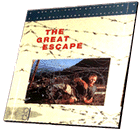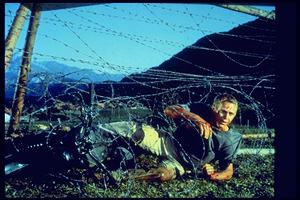

USA action
1963
color 173 min.
Director: John Sturges
CLV: out-of-print collectible
2 discs, catalog # CC1273L

Locked behind barbed
wire, the men who lived The Great Escape tunneled their way toward freedom
with nothing but guts, perseverance and ingenuity. With only their bare hands and
the crudest of homemade tools, they sank shafts, built underground railroads,
forged passports, drew maps, faked weapons and tailored German uniforms and
civilian clothes. They developed a fantastic security system to protect
themselves from the German "ferrets" who prowled the compounds with
nerve-wracking tenacity and suspicion. It was a split-second operation as
delicate and as deadly as a time bomb. It demanded the concentrated devotion and
vigilance of more than 600 men -- every single one of them, every minute, every
hour, every day and every night for more than a year. Never has the human
capacity been stretched to such incredible lengths or shown with as much
determination and courage.It all really happened. In the motion picture we
made about it, we used as much of the actual detail of physical things and of
technique as we could possibly cram in, and as many players reflecting the
endless variety of character and emotion of the real men as dramatization would
allow. They provided the movie with tremendous excitement, humor and upbeat
vitality.
Then the way it really happened turned to terrible and brutal
misfortune. Only three made it to freedom, and as an escape, this enormous effort
would have to be considered a tragic failure. But this was a story about far more
than trying to get 220 men to freedom. It was about freedom itself. I liked to
think of it as a microcosm of why our (collective) side won, but it was put much
better by George Harsh, an American who was part of it all, in his introduction
to Paul Brickhill's book.
"It is the story of achievement against impossible
odds," he said in part." And it proves something that I believed then and know
now -- there is nothing that can stop a group of men, regardless of race, creed,
color, or nationality, from achieving a goal once they agree as to what that goal
is. The aftermath may be sheer, stark tragedy -- that lies with the gods -- but
the point is, men working together can accomplish anything . . . In one
magnificent gesture the seventy-six ragged, verminous men of all nationalities
who climbed out of that stinking hole in the ground in Silesia on that windy
March night in 1944 thumbed their collective nose at the entire Third Reich and
all it stood for. They triumphed, through the only means left to them, over an
idea that was rotten from the core out."
We tried to consolidate this
indomitable spirit into the character of Virgil Hilts as, at the end of the
picture, he is thrown into the "Cooler" again -- unwilling even to think about
defeat, much less concede it. The Great Escape was a very successful movie
and I take great pride in my part in making it. But that pride is nothing
compared to what I feel about having belonged to one of the societies in the
world that produced men such as these.
-- JOHN
STURGES
Credits
Producer-Director: John Sturges
Screenplay:
James Clavell, W.R. Burnett
Based on the book by: Paul
Brickhill
Cinematographer: Daniel L. Fabb, A.S.C.
Film Editor: Ferris
Webster
Music: Elmer Bernstein
Sound: Harold Lewis
Technical Advisor: C.
Wallace Floody, M.B.E.
Transfer
This edition of The Great
Escape was transferred digitally from a 35mm interpositive in its correct
widescreen aspect ratio of 2.35:1, and released with the approval of director
John Sturges. The soundtrack was mastered digitally from a 35mm magnetic
track.





